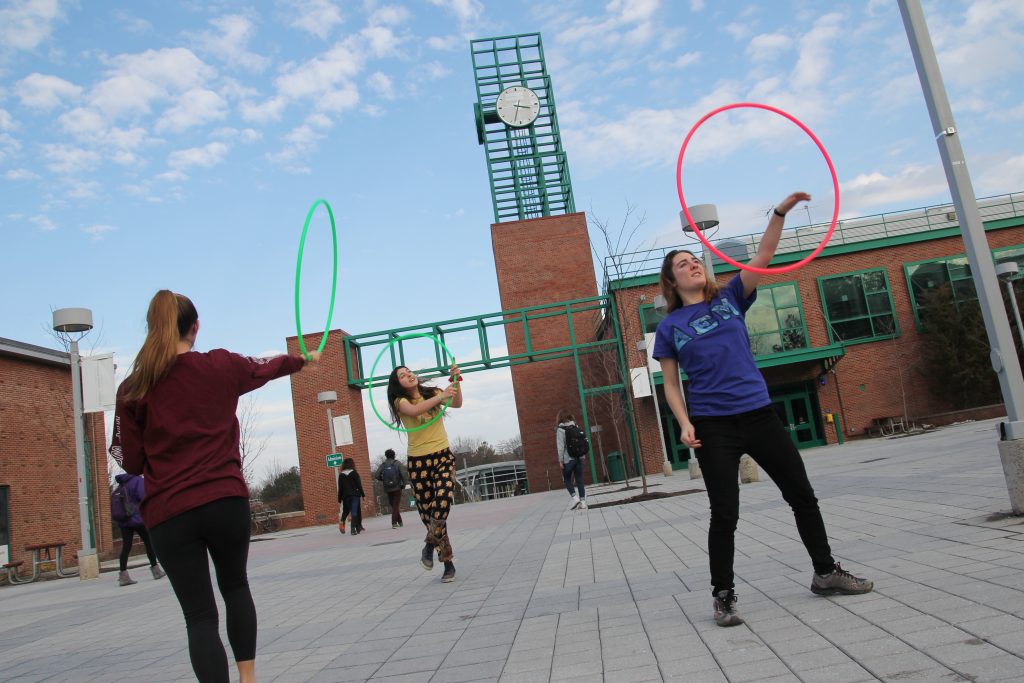
At Binghamton University, the Hula Hoop Club likes to go with the flow.
Members of the Student Association-chartered club have embraced the principles of flow art, a performance style most recently popularized through its prevalence at festivals like Burning Man and Electric Daisy Carnival. BU’s hoop aficionados and members of other clubs like Circus Arts Association are among the growing community of students on college campuses across the country practicing the art of flow performance.
According to Hula Hoop Club member Lily Shoulberg, a senior majoring in English, most flow arts are centered around prop manipulation. Poi — balls that swing rhythmically from the end of a string — are a commonly used prop. Some other popular flow arts involve staffs, torches and, of course, hoops.
Club member Katie McCreesh, a senior majoring in environmental studies, explained that the word “flow” refers to a flow performer’s state of mind, which is a meditative state of movement.
“Once you achieve a certain state of symbiosis with a prop, you don’t even think about what movements you’re doing, it just flows out of you,” McCreesh said.
For members like Shoulberg and McCreesh, after discovering hooping, the next step was to join Facebook groups dedicated to hooping and flow performance. They found a thriving online community of people from across the country who share hooping videos, teach each other new tricks and buy and sell hoops.
This online network of resources has greatly expanded in recent years, and flow arts are even being incorporated into fitness classes for people of all ages. This trend has been true for BU’s club too.
“There were two older women in their 50s or 60s who lived in Binghamton, and they loved to hoop,” McCreesh said. “When they found Binghamton’s hoop club on Facebook, they were so excited and they started coming to meetings every week last semester.”
There’s a small group within the larger club, called Hoop Troop, that choreographs routines to perform at events. Once members learn four or five different tricks, they often want to showcase their skills through performing at competitions, banquets or fundraisers, and are eligible to become a part of the selective team.
Last semester, the Hoop Troop collaborated with the Circus Arts Association as an opening act for the Black Dance Repertoire’s “Circus: Freak Show” dance competition. Members of the team noticed similarities between their own movements and the movements of the circus performers.
“I think you can consider juggling and some of the discs they have as flow props,” McCreesh said. “During the show, one girl went on with two hoops, and one girl went on with two poi, and they were making the same moves and imitating each other with these different toys because it’s all the same principle.”
Many people who hoop also practice another flow art. Although she considers the hoop to be her main prop, Shoulberg has also dabbled in fire flow, which involves torches.
“A lot of the movements in hooping are borrowed from other flow arts, and a lot of the movement theory behind it is the same,” she said.
Members of BU’s Hula Hoop Club agreed that although hooping can be difficult, anyone can learn if they put in the time.
“I like that anyone can do it if they practice enough,” said member Emily Tagarello, a senior majoring in history. “I’m a generally uncoordinated person, so I’m glad it’s something I can do.”
The members say that everyone who comes to meetings learns at least a few tricks.
“I love coming to meetings and seeing people get so much better in just an hour,” Shoulberg said. “There’s no limit to how much you can learn and innovate with it.”


